Menu
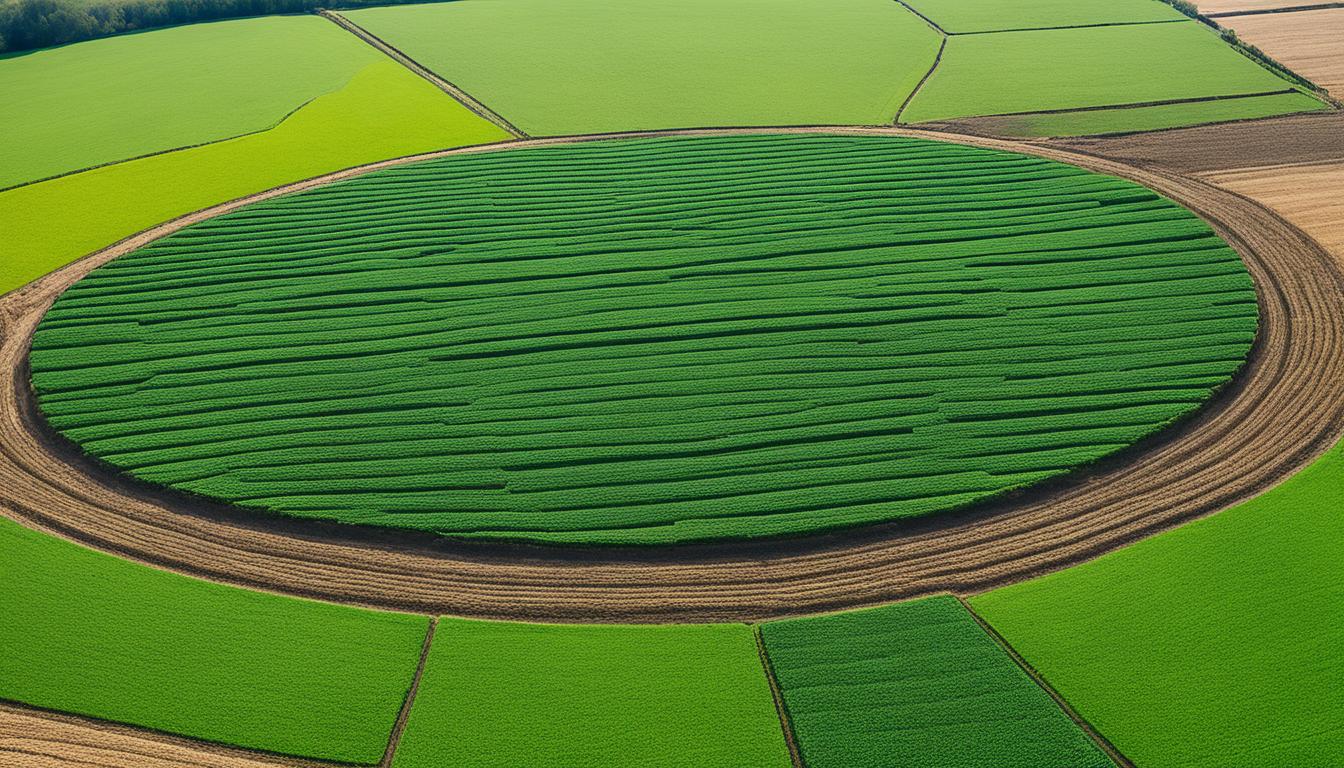
Ever heard of seven dairy farms in the UK being very committed to a big-picture approach to farming? They’re turning more to sustainable ways and showing us how it’s done. This in-depth review, led by Regen Dairy and FAI Farms, looks at what these farms are doing differently, what works, and what hurdles they encounter.
This review uncovers a range of smart farming practices, like mob grazing and fewer chemicals. We learn not just the good stuff, but also the tough bits these farms face. It opens our eyes to new paths in farming towards a greener future.
Sustainable farming is crucial, making regenerative agriculture key in the UK. It focuses on better soil health, more wildlife, and fighting climate change. The dairy industry is especially important for UK farming, leading the way in using regenerative methods.
Around 71% of the UK is used for farming, so sustainability is vital. Seven dairy farms showed real commitment to a full-picture approach. They used methods like mob grazing and cut down on chemicals, proving they can farm in a sustainable way. With up to 60% of organic carbon lost in UK soils, it’s clear we need these new approaches fast.
Regenerative farming aims to keep the soil healthy, make crops varied, and protect from year-round roots. Using animals in farming is also important for the UK’s farm future. A 2019 report by experts detailed these regenerative principles, like fewer soil disturbances and more plant types.
Case studies show both challenges and great chances in this type of farming. Some hurdles include learning new ways and keeping farms productive while being kind to nature. But, the advantages are big, like saving money, better soil, happier animals, and finding new markets. Sharing info through books, webinars, and farmer groups is key in making this change.
| Challenges | Opportunities |
|---|---|
| Adapting to new practices | Reduced input costs |
| Balancing productivity with environmental goals | Enhanced soil health |
| Marketing regenerative products | Improved animal welfare |
| Resource accessibility | Potential for niche markets |
Regenerative dairy farming is more than just milk production. It focuses on healing the land. This new approach is good for the environment and the animals on the farm.
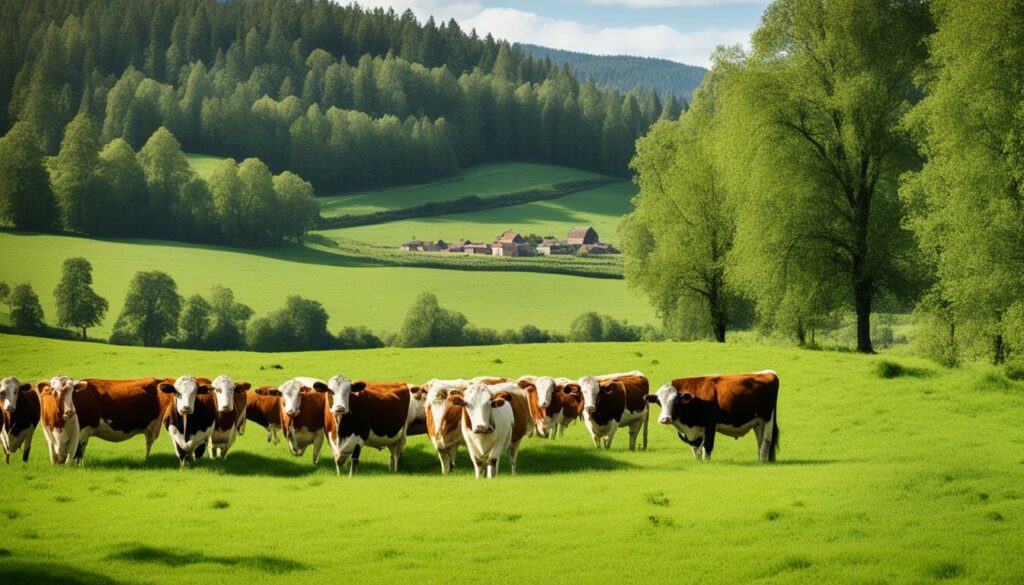
Regenerative dairy farming links soil, animals, and nature. It uses special methods to make the land and animals healthy. Farms grow better grass and help more plants and animals thrive.
They do this by caring for the soil and plants in a special way. This makes everything on the farm stronger and more alive. The use of special grass-feeding methods and careful land management is key.
Farmers have seen a big boost in soil health by using these practices. They have increased the amount of organic material in the soil. This makes the land richer and better for growing things.
A more varied type of grass has been planted. It includes more flowers, which help bees and other animals. These steps are good for the earth and the animals.
Farmers also pay a lot of attention to the health of their cows. By changing how they feed and take care of their cows, they’ve seen fewer sicknesses. This means less money spent on vet bills.
They’ve also stopped giving medicines to their cows unless necessary. This has led to healthier cows. As a result, farmers have noticed their milk and cheese taste better.
| Performance Indicators | Results Achieved |
|---|---|
| Soil Organic Matter | 4-5% to 7-9% in five years |
| Pasture Composition | 50% Legume, 20% Perennial Ryegrass |
| Biodiversity | 86 Bird Species Identified |
| Animal Health | Reduction in Mastitis and Veterinary Costs |
| Milk Quality | Sweeter, More Delicious Products |
| Plant Root Depth | One Meter |
Following these new ways has not only helped the environment but also the economy. Everything they do helps the land, the animals, and the farm as a whole. It’s about making the whole farm system work better together.
The Regen Dairy website looked closely at seven UK regenerative dairy farms. It found insights into their journeys towards sustainable farming. Each farm used different regenerative methods, such as mob grazing and less use of chemicals.
Dan Herdman from Acton Farm in Northumberland has a great story. He switched to regenerative methods, including mob grazing, on 100 acres of his land. With the help of Soilmentor, he’s improved grass and soil health a lot.
These cases showed that regenerative farming faces many challenges. But, there are big advantages like lower costs and better profits. They also end up with healthier soil and better products.
Having the right resources is key. Farmers learn from books, webinars, and social media. They also support each other by networking. Clare Hill and Caroline Grindrod’s “Roots to Regeneration” program has been very helpful. It offers farm training and mentorship for a year.
The table below summarises the key aspects of the regenerative agriculture case studies, highlighting the practices, challenges, and opportunities faced by these pioneering farms:
| Farm | Regenerative Practices | Challenges | Opportunities | Resources Utilized |
|---|---|---|---|---|
| Acton Farm | Mob grazing, herbal leys | Managing rushes and heather | Improved grass quality and soil health | Soilmentor, networking |
| Other Farms (6) | Various: mob grazing, reduced chemical inputs | Adapting new practices, land access | Enhanced soil health, reduced costs | Books, webinars |
The stories of these dairy farms show the UK’s progress in sustainable agriculture. Companies like McCain Foods support these efforts. They are working to make their supply chains more sustainable, reducing the impact of climate change.
These stories show how regenerative farming can change UK agriculture. They lead to a future that’s both sustainable and profitable.
All seven farms aim to better soil health through unique regenerative practices. They also differ in how they boost farm biodiversity. This diversity highlights the richness of regenerative agriculture.
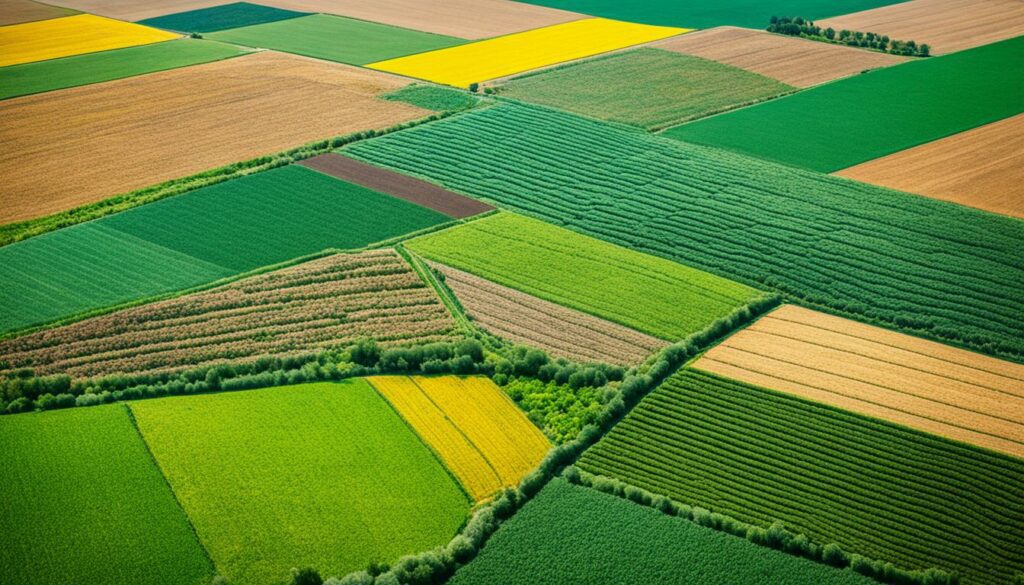
The farms work hard to improve soil health. They use less chemicals, let animals graze in mobs, and manage grass better. These actions help make the soil rich and healthy. With less disruption and more plant types, they follow key steps of regenerative farming.
Farms differ in how they tackle biodiversity. Some focus on adding different animals and plants to the farm, creating a strong and lasting ecosystem. Others work to trap carbon in the soil by picking specific crops and planting methods. But, they all aim to make farming more diverse and robust.
| Aspect | Common Approaches | Varied Approaches |
|---|---|---|
| Soil Health | Mob grazing, reduced chemical inputs, grass management | Specific implementations like cover cropping, no-till farming |
| Biodiversity | Commitment to enhancing biodiversity on farms | Focus on either livestock integration, varied plant species, or carbon sequestration |
| Resource Utilisation | Learning through books, webinars, and farmer networks | Extent of resource utilisation and specific knowledge-sharing networks |
Across the UK, regenerative dairy farms are using mob grazing techniques. Seven studies showed how these methods are key. They help the farms focus on soil health, the well-being of their animals, and being kind to the environment.
Mob grazing means moving big groups of livestock to small areas. This is like how wild herds graze. It is good for the land and helps it renew itself. Sheep and cattle are main players in this. They keep the grass at the right height. For example, sheep graze it short, and cattle eat at different levels.
| Aspect | Impact of Mob Grazing |
|---|---|
| Soil Health | Enhances organic matter, prevents erosion, and boosts fertility. |
| Animal Welfare | Provides a natural diet, reduces dependency on artificial feed. |
| Environmental Sustainability | Minimises carbon emissions, promotes biodiversity. |
| Economic Impact | Reduces input costs, increases profitability through lower vet bills and feeding costs. |
Farms using mob grazing face some hurdles. They need good management skills and have to be committed to how they rotate grazing areas. But there are big benefits. Costs go down, the land gets better, and the animals do well. Farmers can learn a lot from books, online talks, and talking to other farmers. These help them keep up with the latest in mob grazing practices.
Grass management plays a key role in regenerative dairy farming. It enhances soil health and animal well-being. Farmers use these methods to become more sustainable and productive.
Good grass management improves soil health greatly. Organic matter in soil increased on one farm from 4-5% to 7-9% in five years. This helps the soil stay healthy and aids plant growth.
After six years of special grazing, a pasture showed more variety. It had 50% legumes and only about 20% ryegrass. This mix is good for the environment and makes a natural diet for livestock.
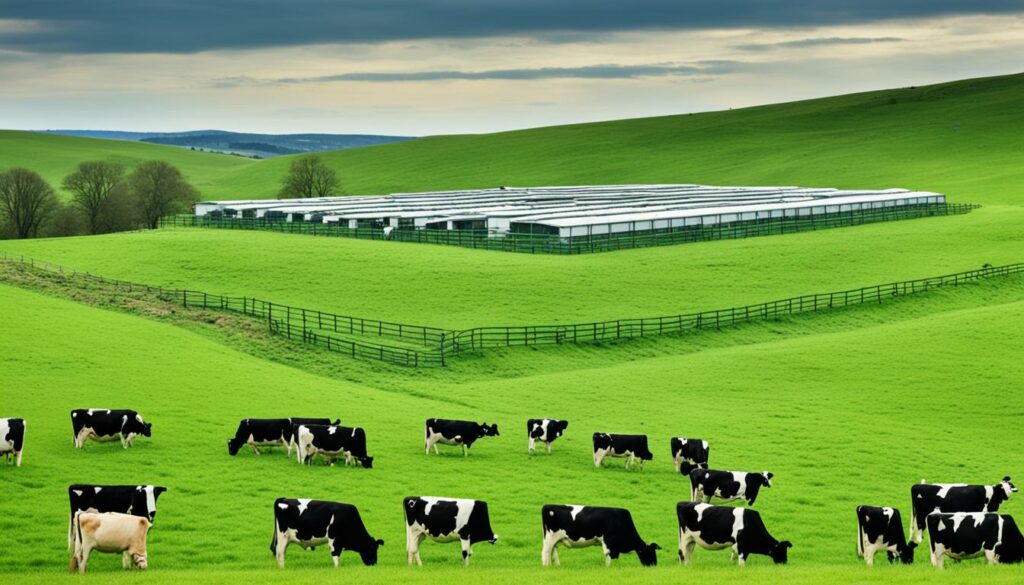
These soil health benefits go down to the roots too. Records show plants can grow roots that reach one meter deep. This shows the soil is full of nutrients. Clean streams nearby prove good water management on these farms.
Dan Herdman from Acton Farm tried mob grazing on 100 acres. His cows move to fresh land each day and the old land rests for 30 days. This method helps the soil and pasture stay healthy.
One farm supports 86 bird species due to its regenerative efforts. This shows how farming can help the environment. The animals are also healthier, needing less vet care. For six years, no calves needed worm treatment and only one cow got sick each year in a 100-cow farm.
Dairy products have also got better. Milk and cheese taste sweeter and customers are happier. Resting paddocks and using short, intense grazing helps. It makes the land and the animals healthier.
All these regenerative dairy examples show the importance of grass management. It’s key for both the soil and the animals. With time, these methods really pay off for farming sustainability.
Agriculture is the second largest contributor to climate change. It releases greenhouse gases and causes deforestation. Moving to regenerative agriculture is vital and offers great potential. It aims to improve soil for future fertility and sustainability, key for long-lasting farming.
Regenerative farming uses principles like not tilling soils much, growing different plants together, and mixing livestock with crops. These mimic natural processes more closely. Regenerative agriculture practices help tackle climate change. They boost the land’s ability to store carbon and water, key advantages highlighted by experts.
Regenerative farms might produce 29% less than traditional ones but earn 78% more profits. This strong difference shows how crucial soil health is. It’s more important than just how much is produced. A US study showed that using methods like no-till farming and covering soil with specific crops increases profits by a huge 207%.
Regenerative farmers do well by selling directly and charging higher prices for organic foods.
Top regenerative farming examples inspire others. Huxhams Cross Farm is a great case. It was once struggling but now serves a thriving food system to hundreds. The farm offers various foods and grains under its successful “Reclaim the Grain” brand, showing how mixed farming can be a success.
Many farmers are now keen to adopt these practices, even those near retirement. The *Feeding Britain* report pushes for wider adoption in the UK. It says these approaches can help fight climate change, benefit nature and health, while keeping the country self-sufficient.
| Motivations | Details |
|---|---|
| Improved Soil Health | Essential for long-term fertility and sustainability. |
| Environmental Impact Mitigation | Counteracting climate change through carbon sequestration and water retention. |
| Economic Benefits | Higher profits despite lower yields; premium prices for organic products. |
| Influence from Forerunners | Success stories like Huxhams Cross Farm inspire and motivate change. |
Switching to regenerative agriculture offers more than just making money. It’s a comprehensive farming approach. It cares for the environment, supports long-term farming, and brings communities together.
In the world of regenerative dairy farming, challenges impact England’s green fields. These hurdles affect both farm success and the environment. The farms champion soil health and animal care, but still face challenges.
Adopting new ways is key in regenerative farming. Learning about soil health and biodiversity is tough. Farmers use books and online help to overcome these challenges.
Techniques like mob grazing require hard work. It’s tough but vital for a healthy ecosystem and better farm performance.
Matching productivity with green goals is hard. Farmers measure soil and biodiversity health each year. This shows the farm’s balance between growth and caring for the land.
Finding the right balance faces obstacles. Selling regenerative products and getting resources can be tough. But it’s vital to balance farm success with environmental care.
Regenerative farming needs a group effort. It means change, learning, and always aiming for a healthy farm and planet.
Regenerative dairy farming brings many benefits. It changes how we farm, improving the planet and our wallets. These changes help everyone, from farmers to shoppers, and the wildlife around us.
Regenerative farming improves the health of our soil hugely. By doing tests, planting cover crops, and using compost, the earth gets better. This makes more room for different plants and animals, making the whole farm stronger against bad weather and other troubles.
A report says that this kind of farming could make the UK’s food system better. It would help the environment and make farms more profitable. The public likes the sound of this, with most people saying they’d like to see more of this farming.
There’s money to be made in smart farming. Lower costs and more ways to earn mean bigger profits for farmers. This includes farming smart, not just producing a lot, and using resources wisely.
A survey showed people are happy to pay extra for food that’s good for the earth and for farmers. This shows that most people see the value in farming this way and are happy to support it.
But, there are some challenges. Finding money to start, knowing how to switch to this new way, and dealing with changes after Brexit are tricky. Solving these problems will help these better farming practices grow.
| Key Benefit | Description |
|---|---|
| Soil Health | Enhances soil fertility and resilience through regular testing, cover cropping, and composting. |
| Biodiversity | Improves ecosystem diversity, fostering better resilience against extreme weather and disruptions. |
| Economic Gains | Reduces input costs and diversifies income streams for greater profitability and financial security. |
| Public Support | Two-thirds of respondents support regenerative farming, with many willing to pay more for sustainable produce. |
Switching to regenerative dairy farming is important for the UK’s future. It deals with money and environment issues. These new ways of farming can make sure everyone gains and enjoys a more secure future.
In regenerative farming, sharing knowledge is key. Both agricultural knowledge sharing and building strong farming networks are vital. Farmers use various ways to learn and share info on regenerative farming resources.
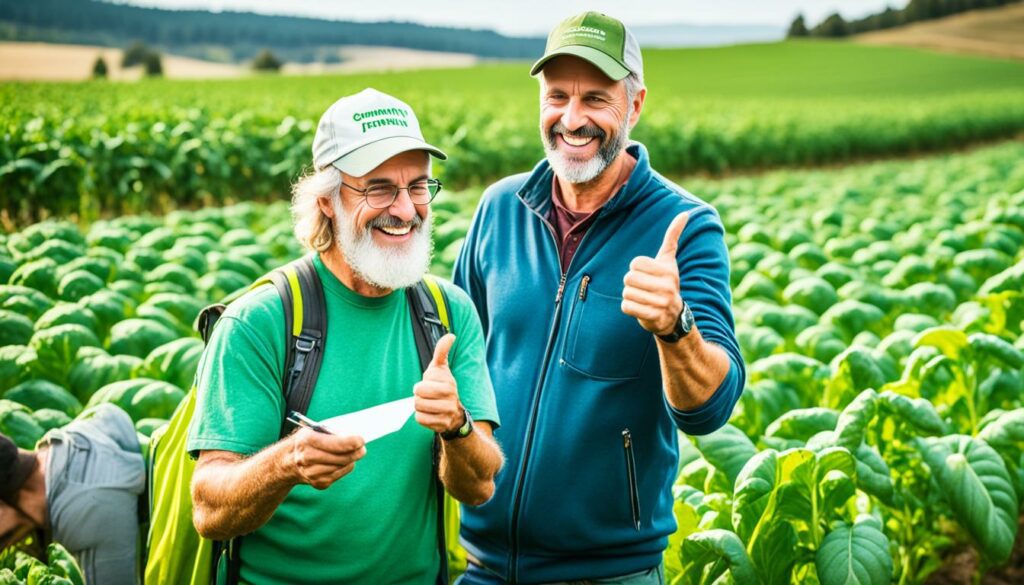
Books and papers are a major way for agricultural knowledge sharing. They talk about 16 key regenerative practices. This includes their impacts on food, soil health, carbon, and biodiversity. Webinars and online seminars are also great. They allow farmers worldwide to learn and share insights.
Farming networks are crucial for farmers. They offer support and share real-life experiences. Collaboration in “Living Labs” is especially effective. It allows for the practical use of regenerative farming resources. Through these networks, farmers can tackle the challenges and seize the opportunities of regenerative farming.
A study looked at regenerative farming against specialist farming. It showed the need for new financial approaches. Slash in input use was a key point. The project got support from the Department for Environment, Food and Rural Affairs (Defra). It highlights the central role of such study efforts in sustainable agriculture’s future.
To sum up, using books, webinars, and joining farmer networks is key in regenerative farming success. They encourage agricultural knowledge sharing and support sustainable practices.
The Lower Hampen Farm case study shows how important regenerative agriculture is. It improves the environment and the economy. This farm in Buckinghamshire has changed to a regenerative model that focuses on both the well-being of animals and making high-quality products. It shares key lessons on the local food and farming connection that help both the community and nature.
According to Maria-Helena Semedo from the FAO, a third of the world’s soil is now poor. If things don’t change, we could lose all our topsoil in 60 years. This is why we need to move to regenerative farming, like Lower Hampen Farm did.
Lower Hampen Farm uses catch crops to make its soil healthier. Ian Gould explains that catch crops need to be grown for six weeks before they’re cut down. Then, they sow other crops. For balance, the farm plants sunflowers among these crops. This mix is good for the soil and the plants. Even though it costs between £35-£45 an acre, it pays off in the long run.
Mr. Ian Waller from Lower Hampen Farm spreads cover crops over the fields without tilling. His mix includes various seeds like oats, radish, linseed, and clover. This mix helps the soil and brings more life to the farm.
The Lower Hampen Farm case study proves that connecting local food with farming is crucial for our planet. Through smart and green ways, the farm makes profits and brings life back to the soil. This shows that regenerative farming is the way forward for food in the future.
André Leu, international director of Regeneration International, says that turning 10-20% of farms to regenerative ways can take out enough CO2 to stop climate change.
This study highlights how regenerative farming changes everything for the better. Lower Hampen Farm is a great example. It shows how taking care of nature, making money, and helping the community can all go hand in hand. It shines as a hope for the future of UK farming.
The Bec-Hellouin Farm in Normandy, France, shows how well regenerative agriculture works. It focuses on permaculture and forest gardens. This way, it changed from traditional methods to successful low-cost farming. The farm’s methods prove that we can restore land and grow crops sustainably without big expenses on machines or fuel.
The farm started by preparing land for hazelnuts. They did this by adding sand. They also transformed a vineyard into various crop fields. They planted aromatic herbs and vegetables for sale and personal use. This mix shows a smart permaculture approach.
They also solved soil issues from years of tractor use by creating permanent beds. This stopped the need for yearly soil tilling. They used composted manure for the vegetables. This helped the soil stay healthy and supported more plant and animal life.
The farm is efficient, using a task schedule and a task priority graph. They also focus on farmer wellness with forest walks and yoga. This keeps them dedicated. Many people worldwide visit the farm to learn its methods for their areas.
Regenerative agriculture needs less money to start than regular farming. The Bec-Hellouin Farm’s finances are well-documented. They show how to plan costs in different places. Although it needs a lot of work and money, the farm suggests starting small. Then, slowly growing is key to success. This way, sustainable farming methods can become more common.
Regenerative agriculture is a holistic farming approach. It aims to enhance ecosystem health. It focuses on improving soil, fostering biodiversity, and capturing carbon. This approach has benefits for fighting climate change, soil issues, and biodiversity loss.
In the UK, regenerative agriculture addresses key environmental issues. These include poor soil health, loss of biodiversity, and climate change. It also looks to improve animal welfare and make farms more profitable.
The core ideas of regenerative dairy farming revolve around four main areas. These are better soil health, good animal care, supporting the environment, and taking a holistic approach to managing land. Practices like mob grazing and varied grass management are key.
These farms all use regenerative methods but focus on different parts. Some are keen on improving biodiversity. Others concentrate on how they manage grass. Each farm tailors its strategies to their own circumstances and goals.
Mob grazing involves moving animals often across small areas of land. This rejuvenates soil, uses grass better, and boosts biodiversity. It’s good for the land and the animals.
Better grass management boosts soil and animal health. It helps with the growth and use of pasture. This keeps the soil fertile and helps livestock stay healthy, leading to better dairy farming results.
Farmers are driven by several factors to accept regenerative farming. They want to improve their land and the environment, be economically sustainable, and learn from leading regenerative farmers.
There are many hurdles when moving to regenerative practices. These include learning new ways of managing land, making sure the farm is still productive, finding markets for regenerative goods, and getting the right help and information.
This type of farming can lower costs, increase earnings, and open up new markets for eco-friendly and welfare-friendly items.
Farmers learn through books, webinars, social media, and connecting with other farmers. These methods help them share knowledge and support each other.
Lower Hampen Farm is known for its successful adoption of regenerative methods. It focuses on animal care and produces high-quality, welfare-friendly products. The farm also works with the local community to promote sustainable food practices.
Bec-Hellouin Farm in France showcases the success of permaculture and forest gardening. It proves high productivity and economic success can be achieved this way. It’s an inspiring model for regenerative farming.